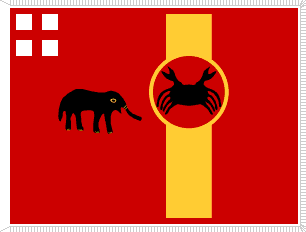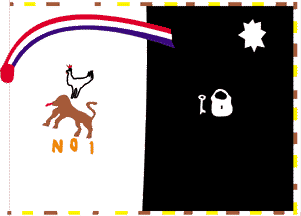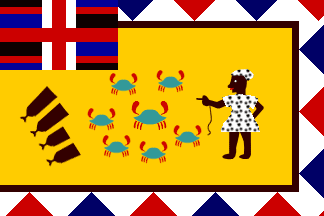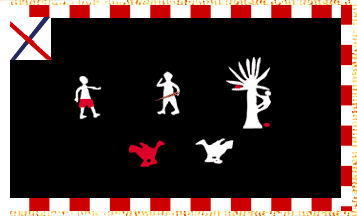 image by António
Martins-Tuválkin, 12 March 2016
image by António
Martins-Tuválkin, 12 March 2016based on this image seen on eBay by Bill Garrison, 15 April 2007

Last modified: 2016-04-16 by ian macdonald
Keywords: crown (red) | canton: cross | elephant (black) | crab | highway patrol | car | policeman | leopard | men: 2 | rainbow | key (white) | padlock | lion | rooster | star: 8 points (white) | no1 | nº1 | crabs: 7 | bell | gong |
Links: FOTW homepage |
search |
disclaimer and copyright |
write us |
mirrors
This flag was yellow in color, with white fringe around 3 sides. In the
left corner was a sort of Union Jack… however, this UJ had no blue, only
the white spaces where the St. Andrew should be, with a red St. George’s
cross, as it should be. The red was faded and sort of look pink.
In the field there was a representation of a Rooster in black with the
crown (?) on top of in red (faded to pink). In the lower right fly was the
number, in white, "No.1". The "No.1" was sewen on both sides of the flag to
read correctly.
Steve Stringfellow, 10 August 1998
The "Nº1" reefers to the company number and the rooster or
“Clock bird” is a symbol of authority and power, i.e.,
he is the one who decides when things are done.
James Ferrigan, 10 August 1998
 image by Thanh-Tâm Lê, 28 December 1999
image by Thanh-Tâm Lê, 28 December 1999
 image by Jarig Bakker, 04 January 2000
image by Jarig Bakker, 04 January 2000
 image by António
Martins-Tuválkin, 12 March 2016
image by António
Martins-Tuválkin, 12 March 2016
based on
this image seen on
eBay by Bill Garrison, 15 April 2007
Seen on eBay - listed as "Flag, Russia, Civil War (1920s?), Regiment?"
What is this?
Bill Garrison, 15 April 2007
By a quick search for "reversed C" I learned all about the "Ɔ"/"ɔ", which is
a kind of "o". This letter is used in many orthographies, especially in Africa
(see e.g.
http://www.bakweri.com/2004/03/the_mokpe_alpha.html), and therefore call it
"African UFE" would be a better hint. I would guess that this is one of those
relatively rare canton-less Fante Asafo frankaa.
António
Martins-Tuválkin, 16 April 2007
This flag has a text in Ashanti (Ghanaian language) starting with "PONKO
ABODAM" which means Crazy Horse (according to
http://prempeh.org/points/houses.html).
Sven S, 26 September 2008
The typical imagery and regiment number («№4») leaves no doubt about the
identity of this flag. The full text is:
PƆNKƆ ABODAM A
NOWURAN ƆMBƆDAM BI
Above and below the horseman. The flag is a ~2:3 red over
white tricolor, the middle stripe slightly wider (approx. 2+3+2) with three
smallish human figures on it, in a single file, facing the fly, and seen in
profile: rifleman, horseman, and pikeman (?) — all dressed and capped in red,
the whole slightly off-centered to the fly. On the bottom red stripe "№4" set
very large and bold.
António Martins-Tuválkin, 11 May 2010
 image by António Martins, 29 August 2005
image by António Martins, 29 August 2005
This one is from the Smithsonian Institution / Textile Museum, shown on line. The Smithsonian webpage suggests that this flag illustrates the saying «If you shoot at a leopard and do not kill it, it is better not to have shot at all», which may be taken from Adler & Barnard’s book [adb92]. The Smithsonian webpage says «this early banner», which may help to date it.
It is a red flag with a typical border, wich covers all three free edges, made from white and black alternating rectangles; the fly edge border seems to have dark brown instead of black, in what may be a later repair (but kept in the rendering above). The flag shows a large white leopard, its hide covered with many stylized spots — black dots surounded by blue, red or buff rings. The leopard is standing on a felled men, of black complexion, green mouth and green eyes with purple pupils (!), limbtips clad in buff garments (?), conical yellow hat and embroidered white loincloth. He’s holding an yellow and buff mace in his right hand and raises the left arm. Facing the leopard, another man, with similar aspect, but standing empty-handed with white eyes and blue mouth, wearing a buff hat. On the bottom fly, the inscription "NO1".
The canton shows a very stylized British union jack indeed a square pattern diveded into four quadrants by a red cross, these filled with a stripped pattern two black and two white stripes, the first and fourth vertically and the second and third horizontally (somewhat suggesting a swastika), with a thin red saltire overall. White fringe on all three free edges; white cloth sleave at the hoist that looks like a later repair, indeed extending over the hoist side pattern of the canton — which is though recognizable under the patch and depicted above as such. The color shades on the photo seem a bit greyish.
António Martins, 29 August 2005
 image by Ivan Sarajčić, 06 January 2000
image by Ivan Sarajčić, 06 January 2000
This is one of the very few asafo flags are so big that they have to be
escorted by many men, or to be presented at a company-post (Aban or Posuban):
In the lower half to the hoist is the company number, the Lion and the cock.
On top of that a rainbow arising from a Posuban. Quite remarkable is that the
posuban literally jumps out of the flag… The rainbow reaches into the
right (black) half. In the center of that field one observes the symbol, which
is most powerful among the Akan-people: Key and Lock ("We are Lock and Key
of the State" — we are in control of the state). The eight-pointed
star Nsoromma completes the claim of control: starlight is seen as
light emanating from the Gods.
Jarig Bakker, 04 January 2000, quoting
[gru95]
 image by António Martins, 31 May 2005
image by António Martins, 31 May 2005
From an on line image, in a links page with no info about it.
It shows a typical Asafo flag, with wide border, naive scene in center and national flag in canton. The latter is a very unusual Union Jack, consisting of a Saint George cross on a stripped background: vertical white stripe over a black, blue and red horizontal stripes of double and single widths.
The border is white with alternating very dark blue and red triangles pointing inside and not touching each other (though this may be due to ill fit of the border), separated from the central area by a thick brown edge. As usual, the border does not include the canton.
The main area is dark yellow and shows seven turquoise crabs with red limbs — six smaller crabs surrounding a larger one (≅⁴⁄₃). At the fly a female human figure, clad and head-dressed in white with black dots, of dark complexion, points to the crabs with a finger of her right hand, which hold the end of a dangling string. Below the canton, four dark brown gongs (?), the lower two clearly smaller.
White fringe in all three free sides, white canvas sleeve along the hoist.
António Martins, 31 May 2005
 image by Ivan Sarajčić, 04 January 2000 | (99×138 cm)
image by Ivan Sarajčić, 04 January 2000 | (99×138 cm)
A man climbs a tree.
The elders of the Fante say, when they see the image of a man climbing a
tree: «When a deceiving man tells you to climb a tree, you have to tell
him to climb it first. If he finds a comfortable spot you can follow
him». The proverb warns for deceit and admonishes the company to healthy
district regarding rival companies. When you look at the birds as well
you can learn a message: «When a hen stays too long in a house it
becomes red (because of dust and earth)».
Jarig Bakker, 04 Jan 2000,
quoting [gru95]
1st figure on the left: white with Sampras-style short red trousers;
2nd figure: white with red stick (sword?)
tree has red papayas between first and second leaf left and right and on
the ground right of the tree; small man (or monkey?) is climbing the
tree.
Thanh-Tâm Lê, 04 January 2000